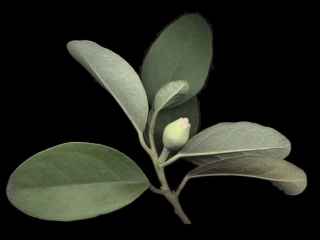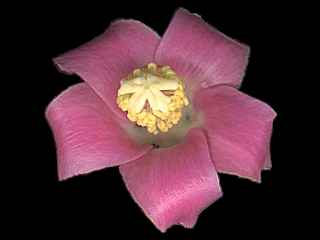Malvaceae Info (Home)
Lagunaria Gallery
Introduction
Lagunaria is a monotypic genus distantly related to Hibiscus. Its single species is endemic to Australia (including Norfolk Island and Lord Howe Island), and is known in the vernacular as the Norfolk Island Hibiscus, and the best part of a dozen other names. It is widely cultivated as an ornamental and amenity tree in warm temperate and moist subtropical regions.
Its closest relative is Howittia, which is another monotypic Australian genus.
Classification
The genus was introduced by Reichenbach in 1828, based on De Candolle's 1824 description of Hibiscus sect. Lagunaria. The genus as currently understood is monotypic, the single species being Lagunaria patersonia (Andrews) G. Don. This species is divided into two subspecies, patersonia from Norfolk Island and Lord Howe Island, and bracteata from Queensland.
The genus was named in honour of Andres de Laguna (d. 1560), a Spanish botanist (and physician to Pope Julius III), and the species in honour of a Colonel W. Paterson who first sent the seeds of the species to England.
Lagunaria lilacina (Lindl.) Sweet and Lagunaria cuneiformis G.Don are synonyms of Alyogyne hakeifolia and Alyogyne cuneiformis respectively.
Lagunaria racemosa, a name found on the web, is a typographical error for Lagun*cul*aria racemosa, which is a mangrove.
Lagunaria patersonia (Andrews) G. Don
![]() Norfolk Island Hibiscus,
Norfolk Island Hibiscus,
![]() Itch Tree, Cow Itch Tree, Itchy Pod Tree, White Oak,
White Wood Tree, Pyramid Tree, Queensland Pyramid Tree, Sally Wood, Sugar Plum
Tree, Tulip Tree, Norfolk Hibiscus,
Itch Tree, Cow Itch Tree, Itchy Pod Tree, White Oak,
White Wood Tree, Pyramid Tree, Queensland Pyramid Tree, Sally Wood, Sugar Plum
Tree, Tulip Tree, Norfolk Hibiscus,
![]() Primrose Tree,
Primrose Tree,
![]() Hibiscus de l'île Norfolk,
Hibiscus de l'île Norfolk,
![]() Weißholz,
Weißholz,
![]() árbol pica-pica
árbol pica-pica
The natural distribution of Lagunaria patersonia is Norfolk Island, Lord Howe Island, coastal Queensland, and perhaps north east New South Wales. The island populations are classified in subspecies patersonia, and the mainland populations in subspecies bracteata. Lagunaria patersonia is in cultivation as an ornamental in many warm temperate and moist subtropical climates, including New South Wales, Victoria and Swanland in Australia, and South Africa, northern New Zealand, Florida, California and Hawaii. It has naturalised in a number of these areas. Subspecies patersonia is the showier plant, and is more frequently represented amongst naturalised populations.
It is recorded from apparently wild contexts in Costa Rica.
Lagunaria patersonia is a small tree growing to 10-15m (35-50ft) in height. In sheltered locations it has a columnar or slender pyramidal habit, but is capable of growing in windswept coastal locations where it develops a contorted wind-controlled shape.
 The foliage is evergreen. The thick, entire, oval leaves are olive
green. The tomentose undersides are silvery when young, and mature to a
grey-green. The leaves are 5-10cm (2"-4") long.
The foliage is evergreen. The thick, entire, oval leaves are olive
green. The tomentose undersides are silvery when young, and mature to a
grey-green. The leaves are 5-10cm (2"-4") long.
 The flowers of Lagunaria are sometimes said to
be hibiscus-like. However it is not obvious to me that they are more similar to
Hibiscus than to other malvaceous
plants, such as Gossypum, Alyogyne or Malva. They are borne freely in summer
and early autumn. They are 1½"-3" across, borne in the leaf axils, on
short, thick, pedicels. There is an impersistent (more persistent in the
mainland subspecies) epicalyx of 3 to 5 broad segments, united at the base,
which in bud is fused and encloses the flower. The sepals are connate, giving a
shortly 5-lobed calyx. The petals are pale pink or mauve in colour, fading to
white, and waxy in texture (the photo above is of a darker than usual flower).
The anthers are borne along much of the length of staminal column, and are gold
to orange in colour. The style is white or cream in colour, and club shaped at
the top, with 5 radiating stigmatic lobes. The style may be the best single
trait for identifying this genus, but lobed stigmas also occur in
Gossypium and some allied genera.
The flowers of Lagunaria are sometimes said to
be hibiscus-like. However it is not obvious to me that they are more similar to
Hibiscus than to other malvaceous
plants, such as Gossypum, Alyogyne or Malva. They are borne freely in summer
and early autumn. They are 1½"-3" across, borne in the leaf axils, on
short, thick, pedicels. There is an impersistent (more persistent in the
mainland subspecies) epicalyx of 3 to 5 broad segments, united at the base,
which in bud is fused and encloses the flower. The sepals are connate, giving a
shortly 5-lobed calyx. The petals are pale pink or mauve in colour, fading to
white, and waxy in texture (the photo above is of a darker than usual flower).
The anthers are borne along much of the length of staminal column, and are gold
to orange in colour. The style is white or cream in colour, and club shaped at
the top, with 5 radiating stigmatic lobes. The style may be the best single
trait for identifying this genus, but lobed stigmas also occur in
Gossypium and some allied genera.
The flowers are succeeded by fuzzy brown, 5-valved loculicidal, capsules which are retained on the tree for some months. The interior of the capsule is filled with white 'fibre-glass' hairs, which are irritant, and responsible for the vernacular names of Itch Tree and Cow Itch Tree. The seeds are smooth and kidney-shaped.
Cultivation
In Australia it is cultivated in Queensland, New South Wales, Victoria, Tasmania, South Australia and Swanland. It is in disfavor in several regions as an amenity tree, both because of the nuisance value of the seed pod hairs, and because of it naturalising and competing with native vegetation.
Elsewhere it is cultivated as a street or park tree in California, Florida and Hawaii in the United States, in South Africa, in northern New Zealand, and in southern Europe.
Lagunaria patersonia is best grown in full sun. It is resistant to salt spray and periods of drought, and is therefore suitable for coastal locations. It is mostly intolerant of frost (described as hardy to -5°C) and is not suitable for growth outdoors, without frost protection, in a cool temperate climate.
It is too large for regular use as a greenhouse plant. However it flowers when quite small, and therefore can be used for some years as a conservatory or patio plant. When so treated it should be repotted, if necessary, in early spring before new growth begins. Any pruning to curb its growth, or to control its shape, is best performed after flowering. A winter nighttime temperature of 7-10°C, with daytime temperatures a few degrees higher, is recommended.
Lagunaria patersonia can be grown from seed. It is also said that it may be propagated by means of semiripe cuttings in summer.
Cultivar
Lagunaria patersonia 'Royal Purple' is a purple flowered cultivar in commerce in California and Britain.
Hazards
The hairs within the seed pods cause skin irritation.
There is a reference on the web to the use of an extract of the bark of Lagunaria patersonia as a herbal remedy. Passing over the question of the efficacy and safety of herbal remedies in general (I am a sceptic) I believe that this reference is in error and results from a confusion between two very different trees which happen to share the vernacular name of White Oak.
Pests
A fungal pathogen of Hoheria and Plagianthus (Nectria hoheriae) has jumped to Lagunaria in New Zealand, specifically in the Nelson and Wellington areas, at the southern fringe of the region of New Zealand in which Lagunaria is hardy.
Also in New Zealand, Lagunaria is attacked by olive scale or black scale (Saissetia oleae).
Images
Synonyms: Synonyms of Lagunaria patersonia include Hibiscus patersonia Andrews, Laguna patersonia Sims, Laguna squamea Vent. and Solandra squamea Poir.
Hibiscus patersonii and Lagunaria patersonii are persistent typographical variants.
Photographs are © 2001 G. Keena, and are reproduced with permission.
If you have found any errors on this page, or have any further information about the genus Lagunaria then please contact me at botany@malvaceae.info.
© 2001, 2003 Stewart R. Hinsley